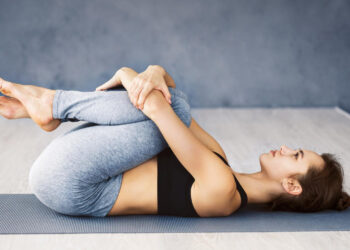A strong, stable core is the foundation of a powerful, agile body. Many people have turned to crunches as their go-to move to get it. While the crunch does an effective job of working the upper abs, it doesn’t work the entire core.
For that, you need an exercise that works the midline’s front, sides, and back. Enter the plank.
As a seasoned personal trainer, I’ve seen the transformative power of the plank in terms of core strength, improved balance, and better posture. In this article, I’ll share nine of my favorite plank variations, complete with their benefits and ideal form.
1. High Plank
The high plank strengthens the entire core, including the abdominals, obliques, and lower back. It also engages the shoulders, chest, and quadriceps, promoting overall stability and posture.
How to Do It:
- Get down on the floor with your hands placed slightly wider than shoulder-width apart.
- Your legs should be straight, and you should rest on your toes. Straighten your arm to come up to the high plank position.
- Keeping a straight line from your neck to your heels, tighten your stomach, and tense your lower back (erector spinae) muscles. Lengthen your body as you hold this position.
- Hold this position for the designated time.
2. Forearm Plank
The forearm plank targets the entire core, particularly emphasizing the stabilizing muscles in the shoulders and lower back. It also promotes better posture and spinal alignment. Because you are closer to parallel to the floor than the high plank, this version works your core more directly than the high plank.
How to Do It:
- Position your elbows under your shoulders and rest your forearms on the floor.
- Spread your palms out on the floor. Your feet should be together with your toes resting on the floor. At this stage, your hips should be on the floor.
- Tense your core as you lift your hips, creating a straight line from your neck to your tailbone.
- Hold this position for the designated time. Begin with 15-30 seconds and progress to a minute or more.
3. Side Plank
Side plank primarily targets the obliques, strengthening the muscles responsible for lateral stability. It also engages the shoulders, hips, and glutes, promoting better overall balance.
Level Up Your Fitness: Join our 💪 strong community in Fitness Volt Newsletter. Get daily inspiration, expert-backed workouts, nutrition tips, the latest in strength sports, and the support you need to reach your goals. Subscribe for free!
How to Do It:
- Lie on your side, with your bottom elbow resting on the floor. Stack your legs with your knees bent at a 90-degree angle and the lower legs resting on the floor. Your hips and shoulders should form a straight line.
- Place your upper hand on your hip, tense the obliques, and hold the position for 15-30 seconds.
- To progress to a more challenging version of the side plant, straighten your stacked legs and rise so that just your lower foot and forearms are in contact with the floor.
- Repeat on the other side.
Learn more about the side plank.
4. Plank Pulse
Plank pulse adds a dynamic element to the traditional plank, increasing the challenge to the core muscles and enhancing endurance. It also improves coordination and proprioception.
How to Do It:
- Get into a low plank position with your forearms on the floor.
- Drop your hips straight down to touch the floor and then back to the straight line position.
- Do not allow your hips to rest on the floor: maintain a fluid up-down movement.
- Keep your core tight throughout the exercise.
5. Reverse Plank
The reverse plank strengthens the posterior chain, including the lower back, glutes, and hamstrings, while also engaging the core and shoulders. It helps counteract the effects of sitting and improves spinal mobility.
How to Do It:
- Sit on the ground with your legs extended and feet together.
- Place your hands on the floor behind you, palms on the floor, and fingers pointing away from you.
- Tense your core and lift to a bridge position. Keep a straight line from your neck to your ankles, and do not allow your hips to drop.
- Hold for the recommended time.
6. Side Plank Crunch
Side plank crunch combines core stabilization with dynamic movement, targeting the obliques and improving lateral strength and agility. It also enhances coordination and balance.
How to Do It:
- Assume the side plank position with your elbow directly under your shoulder, legs extended, and feet stacked upon each other. Your shoulders, hips, and knees should form a straight line.
- Extend your upper arm over your head.
- Bring your upper elbow and upper knee toward one another in a crunching action. Squeeze your oblique muscles as you perform the crunch.
- Repeat for recommended reps before switching sides.
7. Plank Jack
The plank jack elevates the heart rate while challenging the core and shoulder stability. It improves cardiovascular fitness and coordination while toning the abdominals and lower body.
How to Do It:
- Get down on the floor with your hands slightly wider than shoulder-width apart and palms on the floor.
- Your legs should be fully extended.
- Straighten your arm to come up to the high plank position.
- Keeping a straight line from your neck to your heels, tighten your stomach, and tense your lower back (erector spinae) muscles.
- Jump your legs wide apart and then immediately back in a fluid, continuous motion.
8. Moving Plank
Moving plank enhances core strength and endurance while improving shoulder stability and coordination. It also targets the stabilizing muscles along the spine, promoting better posture.
How to Do It:
- Assume the high plank position with your hands directly under your shoulders, body straight, and toes contacting the floor.
- Bring your elbows down to rest your forearms on the floor.
- Immediately reverse the action to return to the high plank position.
9. Mountain Climber
It is a dynamic core exercise that elevates the heart rate and provides cardiovascular benefits. It works your whole core, including the abs, obliques, and hip flexors.
How to Do It:
- Assume the high plank position, with your hands under your shoulders, feet shoulder-width apart, and your body forming a straight line from neck to ankles.
- Drive your right knee toward the chest, then back down.
- Repeat with the left knee.
- Alternate between legs to complete the rep count.
- Do not allow your hips to lift as you do this exercise.
Want to take your core training to the next level? Check out our weighted plank guide.
Level Up Your Fitness: Join our 💪 strong community in Fitness Volt Newsletter. Get daily inspiration, expert-backed workouts, nutrition tips, the latest in strength sports, and the support you need to reach your goals. Subscribe for free!
10. Plank Shoulder Tap
Plank shoulder tap improves core stability, shoulder strength, and mobility. It targets the abdominals, obliques, and stabilizing muscles, promoting better overall balance and coordination.
How to Do It:
- Get into a high plank position.
- Maintaining a straight line from your neck to your heel, tighten your stomach and tense your lower back (erector spinae) muscles.
- Lift your right hand off the floor and tap your left shoulder before returning it to the floor.
- Repeat on the other side.
5 Most Common Plank Mistakes
Most exercisers perform the plank with a time target. The longer the set, the more challenging the exercise gets, which can lead to compromised form.
Here are the five most common plank mistakes to watch out for:
- Dropping the Hips: As the plank gets harder, there is a tendency to let the hips sag. This will strain your lower back and reduce the effect on your frontal core as your abs relax. Maintain a straight line from your neck to your heels, and keep your abs tight the whole time.
- Arching the Back: Excessive back arch will also cause lower back strain and take emphasis off your front core. Concentrate on pulling your navel toward your spine without overarching the lower back.
- Improper Shoulder Alignment: Rounding the shoulders can hamper stability and increase shoulder injury risk. Your shoulders should be directly above your elbows or wrists, depending on which variation you’re doing.
- Not Engaging the Core: You won’t get maximum benefit if you don’t engage your core. Squeeze your glutes, pull your navel toward your spine, and keep your body tense for the entire exercise.
- Improper Breathing: Breathe in deeply through your nose and out through your mouth during the plank. This can improve core engagement and balance.
3 Plank Variation Benefits
We’ve already discussed how the plank and all its variations can increase core strength and stability. But that’s just the beginning of the benefits you’ll get from adding the plank to your workout routine. Here are three more things it will do for you:
Improve Your Balance
Your core anchors your body. The stronger it is, the greater your balance will be. You can correct yourself if you start to fall or slip, significantly reducing your injury risk.
A 2023 meta-analysis explored the effect of core training on balance, jumping/hitting velocity, and jumping ability in healthy subjects. It was found that regular core training (twice a week for 16 weeks) significantly improved balance, jumping height, and hitting velocity. [1]
Reduce Back Pain
The erector spinae are bands of muscle that run alongside your spine. The stronger they are, the less strain your spine will experience. The plank is a safer way to strengthen the posterior core than sit-ups and crunches, which may result in back rounding.
Enhance Your Posture
The plank targets muscles vital to proper bodily alignment, such as the core, which stabilizes the spine and pelvis; the trapezius and rhomboids, which stabilize the shoulders and upper back; and the hip flexors, which promote better hip alignment.
Dr. Eric Berg, DC, hosts one of the most popular health and wellness YouTube channels, with nearly 12 million subscribers. Dr. Berg is a huge fan of the plank and its variations, having created several videos on the exercise.
In one of them, he mentioned a benefit that I’d never considered:
“The plank strengthens the tendons, ligaments, and muscles because you have to hold this position for a long period… It can also help your back from being unstable, help your coordination when you walk, and reduce pain in your lower back.”
Wrap Up
The plank once considered nothing more than an optional tag-on to your core routine, is now widely regarded by fitness experts as the best core training exercise you can do. One of the great things about this movement is that there are so many variations, so you never get bored.
Select two or three plank variations described above and perform them as a circuit. Start with 30 seconds on each move as you perfect the form. Then, challenge yourself to add 15 seconds to your next and every succeeding workout.
Remember, consistency is vital to seeing results. By regularly practicing plank exercise variations and gradually increasing the duration, you’re strengthening your core and your posture, leading to a healthier and more confident you. So, challenge yourself and reap the benefits of a stronger, more aligned body with each plank variation you conquer.
References
- Rodríguez-Perea Á, Reyes-Ferrada W, Jerez-Mayorga D, Chirosa Ríos L, Van den Tillar R, Chirosa Ríos I, Martínez-García D. Core training and performance: a systematic review with meta-analysis. Biol Sport. 2023 Oct;40(4):975-992. doi: 10.5114/biolsport.2023.123319. Epub 2023 Feb 3. PMID: 37867742; PMCID: PMC10588579.








